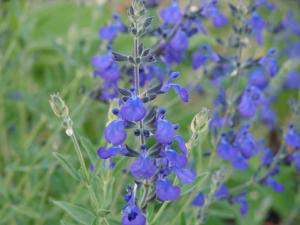Happy Hybrid Surprises from Salvia greggii and microphylla

Sometimes surprises occur in the garden, especially if you plant Salvias.
Salvias that you select to form a harmonious color combination likely will wake up in the spring and bloom as expected in the same way that they did during the last growing season. Of course, problems do arise. Although Salvias are known to flower profusely and reliably, it is possible for something unexpected, such as a fungal attack, to affect the annual show.
However, other unexpected events may also occur. Due to the fact that flowering plants produce seeds, volunteer plants may pop up if you failed to deadhead blossoms before seed formation occurred in the previous growing season.
Happy Accidents May Happen
If short on time for weeding, you may discover hybrid offspring that look different from the parent plants. This is due to cross-pollination by hummingbirds and insects, which can lead to alterations in plant seeds.
Suddenly you realize that Salvias are inclined to cross borders genetically – particularly Salvia greggii and S. microphylla species -- and that your carefully constructed garden is really an unruly nursery. Depending on your point of view, this may be a joyous event, especially if one of the natural hybrids turns out to be a beauty. This is how new cultivars are discovered.
At Flowers by the Sea, we carry a combination of distinct species grown from plants found in the wild and some of their distinctly gorgeous offspring.
Some Species and Their Babies
Two good parent/child examples are the large-blossomed Mexican Sage (S. Darcyi) – sometimes called Darcy’s Mexican Sage, and its smaller-blossomed, yet equally crimson hybrid John Whittlesey (S. x ‘John Whittlesey’). Another pair is the rich beet-purple Coahuila Sage (S. coahuilensis) and its equally stunning offspring Sally Greenwood Sage (S. x ‘Sally Greenwood’), which has bluish-purple flowers that light up the landscape like a string of holiday lights.
The “x” in each hybrid’s name indicate that they are the result of crossings between two species of Salvias, as in the pastel Jame Sages (S. x jamensis) varieties that result from crosses of Autumn Sage (S. greggii) and Mountain Sage (S. microphylla).
Sally Greenwood’s other parent is thought to be either Royal Purple Autumn Sage (S. muelleri) or Marine Blue Sage (S. chamaedryoides). The other half of John Whittlesey’s heritage is some unidentified Mountain Sage (S. microphylla), so it also inherits the Spanish name of “Mirto de Montes” or myrtle of the mountains and the characteristic of tiny leaves.
Sally Greenwood Sage is not a demanding beauty. Although this hybrid looks better with some watering, it flowers best when irrigation is on the lean side. It generally reaches 30 inches tall and 36 inches wide, but may spring up to a height of 36 inches. Give Sally Greenwood a gentle shearing between bloom times and she stays attractively compact. Similar to John Whittlesey, this hybrid likes full sun. It makes a fine groundcover or border plant in Zones 8 to 11.
John Whittlesey Sage is named for John Whittlesey of Canyon Creek Nursery and Design in Oroville, California. This vigorous, long-blooming hybrid is better suited to the humidity of the Coastal West than other kinds of Mountain Sage (S. microphylla). However, similar to other Mountain sages, it flowers in spring and fall. Expect it to grow 48 inches tall and 60 inches wide to form either a tall groundcover or a fragrant border plant. It does well in Zones 6b to 9.
Questions
If you happen to live in a USDA zone that is agreeable to both of these Flowers by the Sea favorites, you may want to plant them together. Given the cool, soothing purple of Sally Greenwood and the heat of John Whittlesey’s bright salmon red, these Salvias make a striking couple in the garden. One can only imagine what may result. Call or email us at FBTS if you want to know more about the S. greggii and S. microphylla Group of drought-resistant sages or need to ask questions about happy accidents in your garden.
Updated 4/21/2016

 Salvia x 'Christine Yeo'
Salvia x 'Christine Yeo'  Salvia muelleri
Salvia muelleri  Salvia coahuilensis
Salvia coahuilensis  Salvia darcyi 'Pscarl'
Salvia darcyi 'Pscarl'  Salvia x 'John Whittlesey'
Salvia x 'John Whittlesey'  Salvia x 'Sally Greenwood'
Salvia x 'Sally Greenwood'
Comments
There are no comments yet.